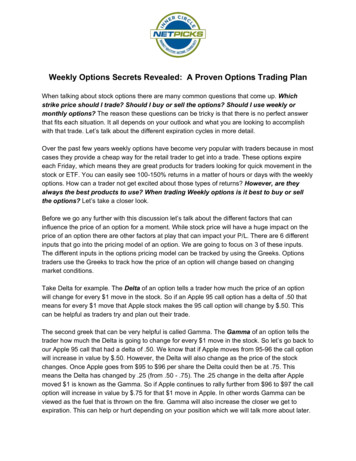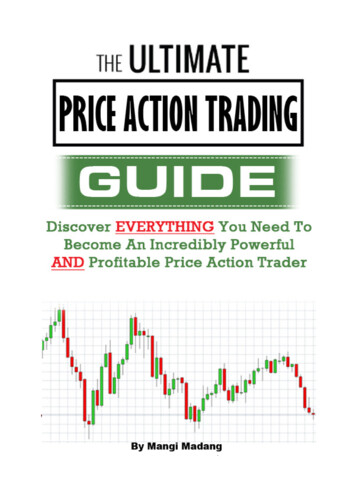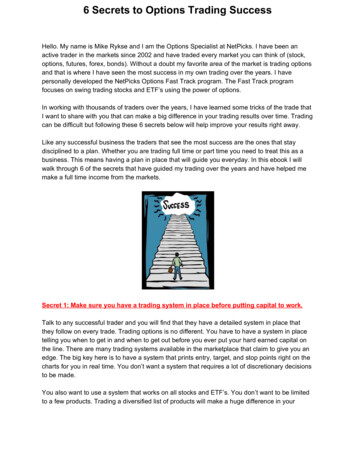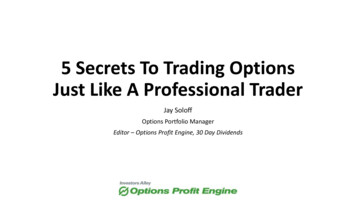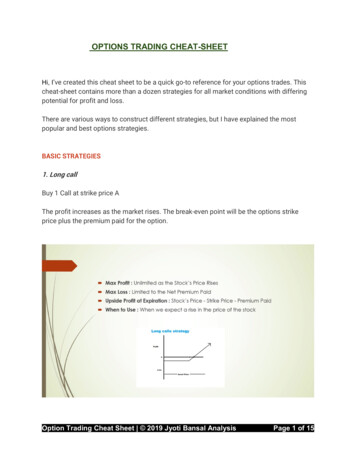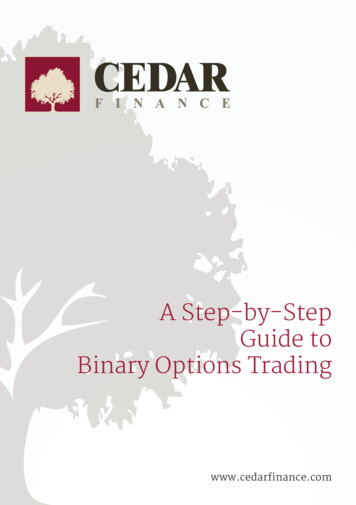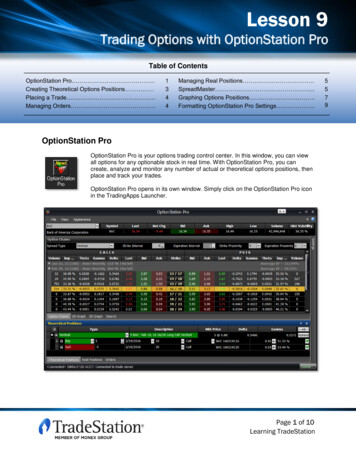
Transcription
Options Trading 101:The Ultimate BeginnersGuide To OptionsBy Gavin McMasterThe information provided in this book is for general informational and education purposes only. None of theinformation provided in this webinar is to be considered financial advice. Any stocks, options and trading strategiesdiscussed are for educational purposes only and do not constitute a recommendation to buy, sell or hold. Optionstrading, and particularly options selling, involves a high degree of risk. You should consult your financial advisorbefore making any financial decisions.The material in this guide may include information, products or services by third parties. Third Party Materialscomprise of the products and opinions expressed by their owners. As such, I do not assume responsibility or liabilityfor any Third Party material or opinions.No part of this publication shall be reproduced, transmitted, or sold in whole or in part in any form, without theprior written consent of the author. All trademarks and registered trademarks appearing in this guide are theproperty of their respective owners.www.optionstradingiq.com 2020 IQ Financial Services, LLC. All Rights Reserved
ContentsWhat Are Options?Why Use Options?Option FeaturesUse Cases of OptionsOption PricingHow To Read Option QuotesMargin RequirementsOption Assignment and ExerciseOption VolatilityOption GreeksPayoff DiagramsRisks When Trading OptionsThe Best Option BrokersBasic Option StrategiesOption Definitions
What Are Options?INTRODUCTIONFinancial derivatives have been around for at least 200 hundred years since the Japanese introduced thefirst secondary market for derivatives related to commodities. Nevertheless, they made their debut inthe U.S. after the Chicago Board of Trade was founded, in 1848, to organize commodities tradingactivities. These markets introduced futures and opened the doors for many new financial instrumentsincluding options. In this chapter, we will explain the basics of how options work and how they are usuallyemployed in today’s modern financial markets.An option is a contract between two parties giving the taker (buyer) the right, but not the obligation, tobuy or sell a security at a predetermined price on or before a predetermined date. To acquire this right,the taker pays a premium to the writer (seller) of the contract.CALL OPTIONSA call option is a financial contract that gives the holder the right, but not the obligation, to purchase acertain underlying asset at a certain price, known as the strike price.For example, ABC Corporation is trading at 120. A one-month call option is trading for 3.50.The buyer of this call option has the right, but not the obligation to buy 100 shares of ABC for 120 pershare at any time during the life of the contract. For this right, the buyer of the contract pays 3.50 tothe seller.The seller of the contract receives and keeps the 3.50 but is obligated to deliver 100 shares at 120 ifcalled upon to do so.PUT OPTIONSIn turn, a put option is a financial contract that gives the holder the right, but not the obligation, to sella certain underlying asset at the strike price on or before expiry.Using the example of ABC Corporation trading at 120, a one-month put option is trading at 4.00.The buyer of this put option has the right, but not the obligation to sell 100 shares of ABC for 120 pershare at any time during the life of the contract.For this right, the buyer of the put contract pays 4.00 to the seller.The seller of the contract receives and keeps the 4.00 but is obligated to buy 100 shares at 120 if calledupon to do so.
RIGHTS AND OBLIGATIONSThe fact that the individual or institution who holds the option has the right and not the obligation toexercise the derivative means that if the result of the operation turns out to be unprofitable, the holdercan abstain from completing the transaction and his sole loss would be the premium paid to purchasethe option.On the other hand, if the holder does exercise the option, the seller of the option must fulfill the contract.Why Use OptionsOptions can be used for four main purposes: Hedging/Risk ManagementLeverageIncomeSpeculationHEDGING / RISK MANAGEMENTOptions are a fantastic tool for hedging exposure to a certain asset. Let’s say an investor has a portfolioof S&P500 stocks and is concerned about a drop in their value over the next few months.
Buying an SPX put option would give the investor some downside protection. If the S&P500 falls, thevalue of the investors stock portfolio will drop, but he will have made some profits from the bought putwhich will help offset the losses.This is a simple example and there are many different ways in which options can be used for hedgingand risk management.LEVERAGESince options cost only a small fraction of the price of the underlying asset an investor can gain a largerexposure to a certain security by buying put or call options instead of buying the underlying assetdirectly. This particular feature of options is known as leverage.Let’s say you want to invest in ABC Corporation stock, as you think the price of its shares will go up overthe next 3 months. If you have 1,000 and the shares cost 50 you could only buy 20 shares.Instead, you could buy 2 call option contracts for 500 that give you the right to buy 100 ABC Corporationshares at 50, 3 months from now.If the price of ABC’s shares goes up to 60 you will earn a 20% return if you invested in the shares directly.At expiry, the 50 call option would be worth 10 with the underlying stock trading at 50. In this case,the call option has achieved a 100% return.However, leverage cuts both ways and if the stock doesn’t move as expected, the investor could lose100% of their investment.INCOMEUsing options to generate income is a popular strategy with investors. Covered calls are a logical placefor stock investors to start because it is an easy scenario to understand.Investors who sell call options on shares they own, can produce an income in addition to any dividendsearned.By selling a call option, the investor gets to keep the option premium, but there is a possibility that theshares will get called away if the stock price rises above the strike price of the sold call.Covered calls will be covered in more detail shortly.Other investors will use options to generate income on shares they have no ownership of via moreadvanced strategies such as vertical spreads, iron condors, calendar spreads and butterflies.SPECULATION
Many investors and traders will use options to speculate on the market. Those expecting the market torise might buy call options in the hope of making a large potential return.Those expecting the market to drop might buy put options.Other traders may opt for income generating strategies.The great thing about options is that there are many strategies that can be used, no matter what yourmarket outlook or opinion.Option FeaturesIn this chapter, we’ll take a look at the seven basic characteristics of all option contracts: Underlying AssetCall vs PutContract SizeExpiration DateStrike PricePremiumAmerican Vs EuropeanUNDERLYING ASSETAs we know, the definition of an option is that it is a contract giving the owner (buyer) of the optionthe right (but not the obligation) to buy or sell a defined quantity of a defined asset. This asset is calledthe underlying asset or sometimes just underlying.Options can be traded on many different underlying assets, particularly in the United States and theuniverse of underlying assets has expanded rapidly in the last five to ten years.The most common underlying assets are common stocks (shares in companies trading on the stockexchange).Other popular assets for option traders include indexes such as the S&P 500, Nasdaq and Russell 2000.The Russell 2000 is a particular favorite with option traders because of the high volatility, high liquidityand 10 point strikes.Options can also be traded on futures, bonds, interest rates, currencies and ETF’s.
CALL VS PUTThere are two basic types of options – call options and put options. As a reminderA call option gives you the right, but not obligation, to buy the underlying asset.A put option gives you the right, but not obligation, to sell the underlying asset.CONTRACT SIZEAn options contract represents exposure to a number of underlying shares. The standard contract sizeis generally 100.This can occasionally change if there is a corporate action such as a reorganization or a new issuance ofshares.In the case of an index option, the contract value is fixed at a certain number of dollars per index point.The size of the contract is equal to the index level x the dollar value per index point. For example,S&P500 (SPX) options have a value of 100, so for an option contract with a strike price of 2,800, onecontract would be 2,800 x 100 280,000.EXPIRATION DATEOptions have a limited life span and expire on a certain date. The expiration date is the day on whichall unexercised options expire and can no longer be traded. The expiration date is fixed during the lifeof an option and will not change. Any options that are not exercised before expiration becomeworthless.The expiration date for listed stock options in the United States is normally the third Friday of thecontract month or the month that the contract expires. On months that the Friday falls on a holiday,the expiration date is on the Thursday immediately before the third Friday 1.Some brokers will automatically exercise any options that are in-the-money by more than 0.01. If atrader doesn’t want the option to be exercised, they should close out the position prior to expiration.European style monthly Index options also expire on a third Friday of the month, however the lasttrading day for Index options is the Thursday. This can result in a significantly different settlement pricethan the Thursday closing price. You can read here for more details.In the last few years there has been an explosion in the number of weekly options available. In someunderlying instruments like SPX, there are options expiring every few days.1Investopedia: e.asp
STRIKE PRICEThe strike price is the predetermined price for buying or selling the underlying asset.The strike price does not change through the life of the option unless there is a corporation action suchas a reorganization.Depending on the underlying asset, there are usually many different strike prices available.Taking a quick look at SPY options for the next month’s expiration date shows strike prices availablefrom 140 to 225 in 5-point intervals then from 225 to 325 in 1-point intervals, then again from 325 to 400 in 5-point intervals.Compare that to a less popular underlying asset like IYT and we have 155 to 175 in 5-point intervals,then 175 to 200 in 1-point intervals and 200 to 220 in 5-point intervals.PREMIUMThe premium is the price of the option which is determined by the buyer and seller of the option.Option premium is determined by market participants with market makers playing a huge role indetermining the price of options.You can read more about the role of market makers here.Option premiums are quoted in cents per share. To calculate the total premium cost, traders need totake the price in cents times the multiplier. An option contract quoted at 1.20 would cost 120 to buy( 1.20 x 100).Option premiums are higher for high volatility stocks which reflects the chance of higher movement inthe underlying over the course of the options life.For example, an at-the-money call option on a high volatility stock like ROKU trades for around 14.00whereas a similar call on a low volatility stock like JNJ trades for around 4.00.Option premium will also depend on the price of the underlying stock. A stock like AMZN which iscurrently trading at 1720 has at-the-money options trading around 65.Compare that to a low-price stock like GE which is trading at 8.30 where at-the-money options tradefor only 0.20 - 0.30.AMERICAN VS EUROPEAN
The difference between American and European options relates to when the owner of the option canexercise the option. American style options can be exercised at any point during the options life, but aEuropean style option can only be exercised at a single point in its life – the moment it expires.Exercising an option has nothing to do with trading an option and both style of options trade exactlythe same way during their lifetime.The terms American and European have nothing to do with geographic locations. Both types of optionstrade in many places. European style options are very common on American exchanges (SPX, RUT andNDX are all European style options).Use Cases of OptionsLet’s look at some practical examples of how you can make options work for you.INCOME GENERATIONSelling call options against shares already owned is one of the simplest and most rewarding ways to tradeoptions. It’s a great way to get started for those that are new to options.It’s a logical place to start if you’re familiar with share ownership.Selling options over shares you own, generates income in additional to any dividends earned while holding theshares. The risk of course, is that your shares might get called away if they rise strongly. You are also limitedyour upside because any gains the stock makes above the strike price are not captured.Let’s look at a couple of examples:SCENARIO 1: SELLING OPTIONS ON SHARES YOU ALREADY OWNAssume you already hold 100 shares of ABC Corporation as part of a diversified long-term retirement portfolio.The current price is 60 and you would be happy to sell your shares if the price reached 62.50. You look in yourbrokerage account and see that a 3-month 62.50 call option is trading with a bid price of 0.98 and an ask priceof 1.02.You place an order to sell the 62.50 call option for 1.00 which is the mid-point of the bid-ask spread.Assuming your order gets filled, you will receive 1
Options Trading 101: The Ultimate Beginners Guide To Options By Gavin McMaster The information provided in this book is for general informational and education purposes only. None of the information provided in this webinar is to be considered financial advice. Any stocks, options and trading strategies discussed are for educational purposes only and do not constitute a recommendation to buy .
